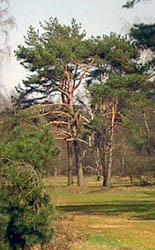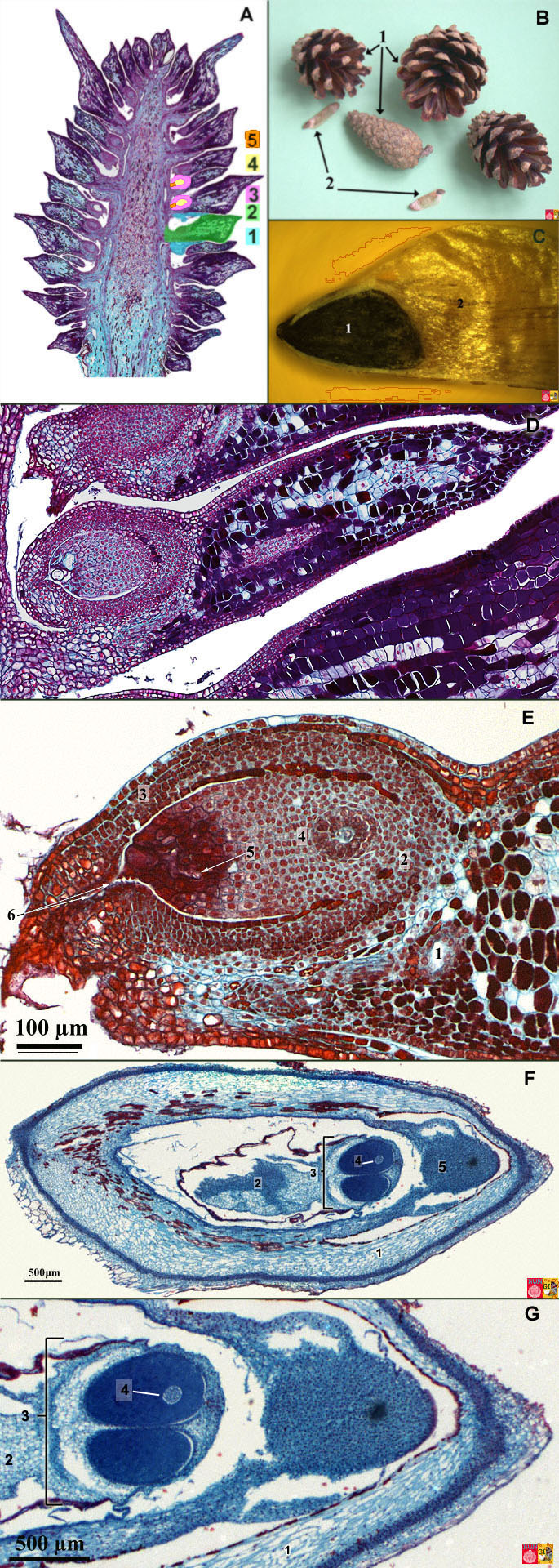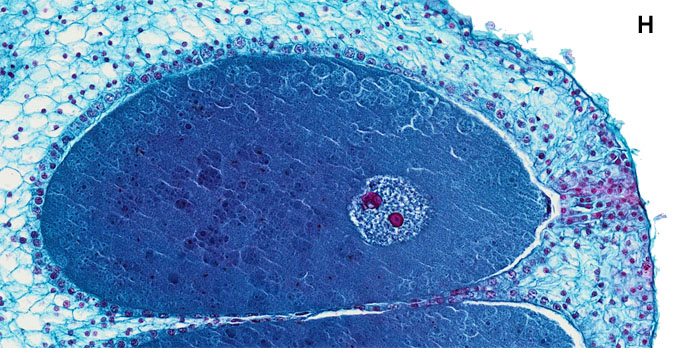Characteristics of the life cycle

The female and male inflorescence of the pine tree develop as cones on the sporophyte. The female cones (female strobili, singular strobilus) consist of megasporophylls that carry uncovered (Gymno = naked / exposed, hence Gymnosperms) ovules. Inside the ovule the megasporocyte undergoes meiosis, producing four haploid cells. One of these cells survive as a megaspore. The megaspore goes through mitotic divisions and forms a small female gametophyte, in which two or three archegonia are present, each with one egg cell.
De male cone is in fact composed of numerous strobili. Each strobilus contains a short appendix and a larger and broader microsporophylls that contains two microsporangia. In the microsporangium microspores are formed after meiosis. These microspores give rise to pollen grains (the proper male gametophyte) after undergoing mitotic divisions. When the microsporangia disrupt a huge number of pollen grains is released into the atmosphere. The pollen grains can be dispersed by the wind over long distances thanks to their air sacs. In fist instance the pollen grain consists of two male prothallium cells (which quickly degenerate) and one antheridium cell: together the gametophyte. A pollen tube cell and a generative cell are formed from the antheridium cell. The generative cell divides in a sterile cell and an immobile sperm cell which reaches the archegonia through the pollen tube and leads to fertilization of the egg cell.
The embryo resulting from fertilization enters a long developmental path that after several years will results in the formation of a mature seed.
![[Schema van de gametofyten en bevruchting bij gymnospermen][Scheme of the gametophytes and fertilization in Gymnosperms)](/images/lifecycles/gymnosperm-scheme-gametophyte_eng.png)
|
|
A Megasporangium with megaspore mother cell (2n), B After meiosis of the megasporocyte: only one of the four haploid cells persists. The pollen grain is germinated, C The megagametophyt develops within the megaspore. D The megagametophyt contains two (or three) archegonia, each with one egg cell. The pollen tube is grown allowing the sperm cell to reach the archegonium . The nucleus of the sperm cell fuses with that of the egg cell: fertilization! E An embryo develops, surrounded by rests of the megasporophyte and there around nucellus tissue F The seed is nearly ripe |
Male organs for reproduction
![[mannelijk strobilus en pollen in Gymnospermen][male strobilus and pollen in Gymnosperms](/images/lifecycles/gymnosperm-male-parts.jpg) |
A Habitat of a pine tree (Gymnosperms) with male inflorescence. Each male inflorescence consists of a large number of strobili arranged in a spiral. Pollen is formed in these cones.
Male inflorescence (2) with strobili (1)
B Detail of the male inflorescence.
C The microsporophylls of the male cones carry two oval pollen sacs. the pollen sac is the microsporangium, in which microspores are formed after meiosis of the microsporocyte. The microspores then undergo mitosis and give rise to pollen grains.
D Longitudinal section through the male cone.
1 microsporophyll, 2 pollen sac with pollen
E Detail of a longitudinal section through the male strobilus of pine (Pinus).
1 microsporophyll (2n), 2 wall of the microsporangium (2n), 3 pollen grains (contain haploïde cells). The wall of the microsporangium disrupts upon drying and the pollen grains are releaed and transported by the wind (anemophylly).
F Detail of the male sporangium (male carrier of spores) of pine. The sporangium contains sporogenic tissue (microsporocytes). Each microsporocyte forms four microspores through a meiotic division. Subsequently, each microspore forms a pollen grain (the microgametophyte) through mitosis.
1 pollen , 2 rest of sporogenic tissue
G Detail of pollen grain of pine
1 air sacs, 2 generative cell
H Detail of a germinated pollen grain of pine, with a pollen tube.
1 air sacs, 2 generative cell, 3 pollen tube, 4 tube nucleus
|
female reproductive organs
The female strobili (singular strobilus) of Gymnosperms contain ovules. The ovule can be found on a megasporophyll, which itself is located on a scale. On each megasporophyll of the female strobilus two seeds can develop after fertilization. In each megasporangium (the female carrier of spores) a megasporocyte is present which leads to four megaspores after meiosis. three of these megaspores degenerate, only one megaspore is functional and forms the megagametophyte with two or three archegonia containig each one egg cell.



|
A Longitudinal secion through a female cone
1 Sterile scale 2 Megasporophyll, 3 Integument, 4 Megasporangium, 5 Micropyle
B Female cones. The ovule can be found on megasporophylls, arranged in a strobilus.
1 female strobili, 2 Seeds with wings
C On each megasporophyll of the female strobilus two seeds can develop following fertilization.
1 Seed, 2 Wing (outgrowth)
D Cross-section through the megasporophyll, megasporocyte and megasporangium (see labels in E).
E Section through the female sporangium
1 Megasporophyl, 2 Megasporangium wall, 3 Integument, 4 Megasporocyte, 5 Tissue of the megasporangium, 6 Micropyle
F section through the megasporangium with egg cell
1 Integument, 2 Megagametophyte, 3 Archegonia, 4 Egg cell nucleus, 5 Rest of megasporangium
G Detail of section through the (female) megasporangium with egg cell
1 Integumenten, 2 Rests of megasporangium, 3 Archegonia, 4 Egg cell nucleus
H Detail archegonium with egg cell
I and J Ripe embryo of pine.
1 Storage product 2 Embryo
|







